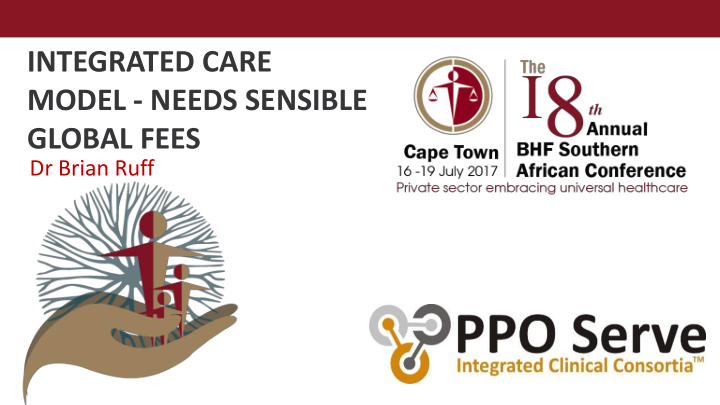



INTEGRATED CARE MODEL - NEEDS SENSIBLE GLOBAL FEES Dr Brian Ruff Presenter Logo
Organising Teams of Clinicians is crucial to achieve higher quality with lower costs PPO Serve: is a healthcare management service, helps organise clinicians into their own Too many private branded teams. Products: Population Medicine hospital beds Rising high in metros or Maternity care or Surgical episodes. Poor OH Scheme benefits (very rich Method: clinical & social support products; IH benefits) premiums data driven improvement; patient workflow High unnecessary system. hospital admission Fees for teamwork & accountability – from rate Fee-for-service Schemes, State or individuals. Tariff for volume, Known factors not outcomes Aging members Multidisciplinary integrated, New technology Isolated Sicker patients Fragmented accountable teams = better clinicians weak system quality at lower costs for Tariff for clinicians working on their patients & populations own Scheme membership – it’s the key reform! shrinking – less funded 2 patients
Getting Global Fees right Current FFS tariff: 1. Pays lone clinicians , not teams • Fragmented care with gaps and waste • Lone clinician is the wrong basis of competition – turns specialists into primary care givers; undermines leadership & fosters value-destructive competition 2. Contains no accountability to patients for outcomes; undermines a culture of continual improvement 3. Leads to over-servicing by clinicians - striving for sustainable income 3
Getting Global Fees right Concerns with over-simple global fee models: • Underservicing: ‘Cutting corners’ to maximise profits by doing less • Patient accountability not addressed - no outcome measures are obligatory • Professional autonomy compromise : = gives financial risk to clinicians - inappropriately transferred from Schemes: • new models ignore patient severity i.e. no risk adjustment • includes non-professional spend (hospital; x-ray etc.) which shortfall they must fund ➢ Having no balance sheet, they enter a subordinate relationship with a hospital or a corporate => may compromise 4 autonomous clinical decisions
Getting Global Fees right Principles to align interests of patients, clinicians, Schemes : • New team models of healthcare service delivery – that deliver EBM outcomes; driven by competition to add value to patients • Fees reflect value produced: consistent outcomes for patients & populations: • Value is the best quality at the most prudent costs • Quality includes outcomes for populations & patient preferences • Carry no undue financial risk: • Autonomous commercial clinician organisation competes & bills • May enter joint projects with hospitals/corporates - as equals; for specific purposes; limited periods (never subordinate) 5
Getting Global Fees right Value based global fees: Structure and intent Fee reflects need and standard chronic complex Over 65 5 3 2 10 professional team + adult 40-65 26 10 4 40 Team female 20-40 12 2 1 15 Risk adjustment male 20 -40 14 1 0 15 management + support child 16 3 1 20 GP 73 19 8 100 standard chronic complex Patient population Over 65 7,7 7,2 9,2 Physicians adult 40-65 15,1 16,9 17,4 Professional female 20-40 8,7 2,4 3,2 male 20 -40 1,0 1,3 1,1 Team Fee child 1,5 3,2 4,0 Paediatricians standard chronic complex Population Need Over 65 1,5 2,4 4,6 Psychiatrists adult 40-65 0,6 1,7 4,3 female 20-40 0,7 1,1 4,2 Psychologist male 20 -40 0,1 1,1 3,8 Social worker child 0,1 1,1 4,0 Disease Burden Index • Billable only by registered clinical team • Carries no financial risk - professional / funder neutral • Monthly or per episode 6 • Outcomes tracking obligation, may be link to Value fee
Value based global fees - Structure and intent + Level 5 ‘ Add on’ value linked fee: + Level 4 i. Add fee once value levels reached ii. Fee level = higher levels = higher value vs. norm + Level 3 iii. Benchmarks reviewed regularly – every 3 years? + Level 2 • Value max = quality max / cost min • Align incentives: team; patient & Scheme • Downstream cost measure & Quality measures e.g.: + Level 1 ➢ Structure: Multidisciplinary Team ➢ Process: Complex patient assessments % ➢ Outcomes: PQI (avoidable admission rate); standardised mortality rate 7
Value-add Contract example Performance bands & Stars Quality + Overall measure Higher quality Higher quality balances quality Lower cost Higher cost & costs - Star system makes it easy to understand Cost + Cost - Lower quality Lower quality Higher cost Lower cost 8 Quality -
NHI White Paper July 2017 - new NB terms • CUP: Contracting Unit for PHC: local District level units, contract to deliver PHC services for catchment area population. Every patient registers to access services. • Contracting Out: government funded privately provided service. • Health Outcomes: changes in health status for individuals& populations – requires data • Multi- disciplinary Teams: ‘ one stop shop’ - doctors, dentists, pharmacists, physios etc. • Quality of Care: safe, effective, patient centered, timely, efficient and equitable provision to achieve desired outcomes. Clinical governance NB. Attracts bonuses. • Risk adjusted capitation: monthly provider payment per head (not per service) • Strategic Purchasing: • Active evidence based analysis of required service mix & volume, then • Select provider mix to maximise societal objectives. (Aims to constantly improve the performance of the healthcare system.)
10
Recommend
More recommend